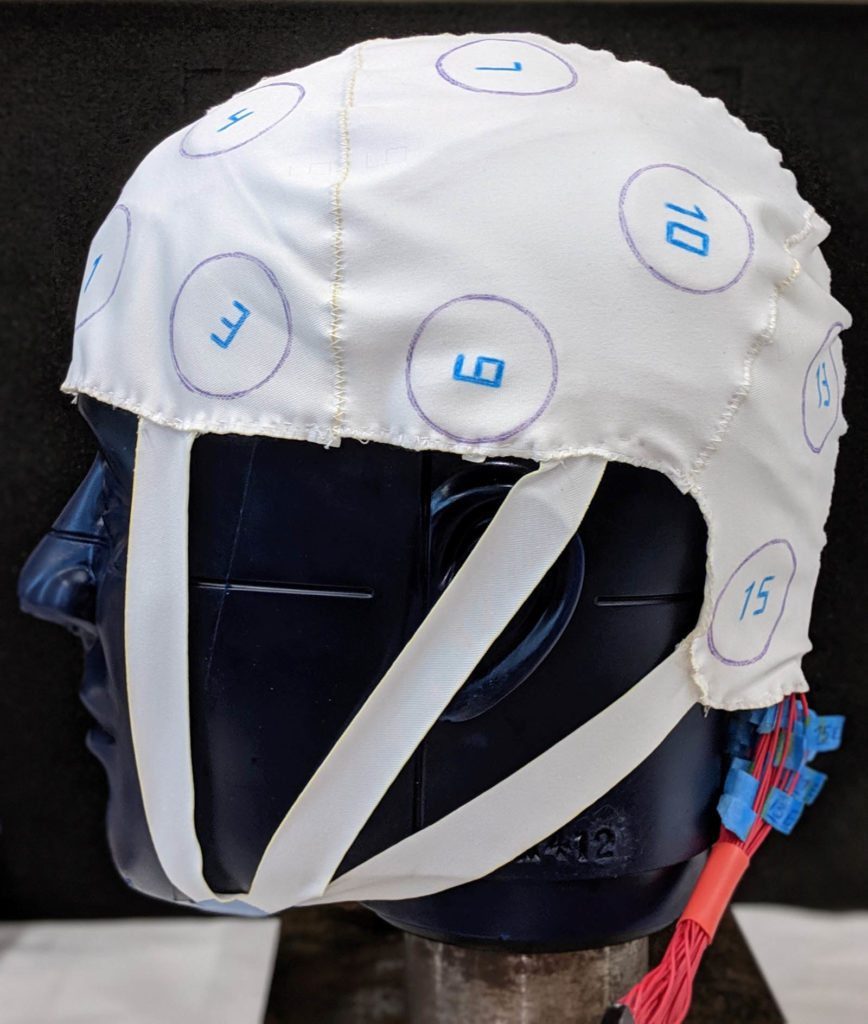Material and design improvements offer better head protection in sports activities.

By Seshadri Ramkumar, Ph.D., and Janet Preus
According to the American Academy of Neurology (AAN), about 1.6–3.8 million concussion cases arise every year due to sports and related activities. These are caused by impact or hard blows to the head. According to AAN, helmets lower death risks due to head trauma, but today’s helmets alone cannot stop all concussions. This necessitates the need for material and design improvements.
The U.S. Consumer Product Safety Commission says that helmets are shock absorbers, like antiballistic materials, that absorb the impact. Standards for helmets used in a variety of sports activities, such as motorcycling, hockey, football and baseball, will vary and are overseen by organizations that developed the standards. These include ASTM International, the European Standards Organization, the National Operating Committee on Standards in Athletic Equipment and others.
While the shell component of helmets are hard materials, liner materials serve as shock absorbers and are, generally, foams and layers of impact-resistant webs. Woven fabrics, soft composites and nonwoven webs can be used on their own or developed into hybrid composites. Recently, there has been interest in using nonwovens as shock absorbers due the ubiquitous arrangement of fibers providing three-dimensional structures. Technologies such as high-loft thermal bonding, vertically arranged webs and needle-punching can be explored to develop liner materials. These methods are suitable to develop medium- to heavy-weight webs, which are also flexible and can be used as liners.
Fit for the job
Materials and design are critical in the construction of protective helmets, but proper fit is equally important. A loose or improperly fitted helmet could leave the wearer vulnerable to traumatic brain injury (TBI), a leading cause of death or disability in the U.S., according to the U.S. Centers for Disease Control and Prevention. Field data suggest that loose or improperly fitted helmets can contribute to TBIs, but no device currently exists that can provide information about how well a helmet conforms to an individual athlete’s head.
To help observe and better understand helmet fit, Western Michigan University professors Simin Masihi, Massood Atashbar and colleagues set out to develop fabric-based sensors that could map pressure in real-time. The result is a prototype pressure sensor cap that, when worn under a helmet, can reveal whether the headgear is a perfect fit.
The researchers made their sensors by placing a porous polydimethylsiloxane (PDMS) layer between two fabric-based, conductive electrodes. They created uniform pores in the PDMS layer by mixing and heating PDMS, sodium bicarbonate (baking soda) and nitric acid, which released bubbles of carbon dioxide gas. When the team applied pressure to the sensor, the porous material compressed, causing a capacitance change as the space between the two electrodes decreased.
To demonstrate a wearable helmet fit system, the researchers added 16 pressure sensors to different locations on a cap. When tested on multiple volunteers wearing a helmet of the same size, the cap accurately indicated that the person with the largest head experienced the greatest amount of pressure. The fit cap could help athletes select the proper off-the-shelf helmet, and custom helmets could be manufactured, as well.

Unconventional and effective
A relatively new product from two former SpaceX engineers offers tested protection, as well as stylish portability – all in the look of a baseball cap. Company co-founders David Hall and Jordan Klein say their Park & Diamond™ foldable helmet complies with U.S., Canadian and European Union safety standards, adjusts for fit, and can collapse to the size of a water bottle to store in a backpack or handbag.
Park & Diamond consists of four layers of protection: 3-D mesh fabric, EVA foam, a polycarbonate shell and a proprietary composite layer. The patented protective composite material is said to be three times more efficient at absorbing and dissipating energy, reducing the force of impact to the head.
Fabric solutions
Little more than a year ago, researchers at the Deutsche Institute für Textil und Faserforschung Denkendorf (DITF) used a 3D weaving process to produce a spacer fabric that can be foam-filled and molded and used in a helmet. Advanced Textiles Source reported this development in its May issue, “Fiber use and placement can be optimized so that additional fibers can be used in the outermost layer where full coverage is required, but innermost towards the head a grid-like formation provides for a snug fit with minimal contact points. This approach maximizes the capacity for shock absorbency while at the same time reducing weight and material use.”
Tests on this approach have indicated that it is possible to increase shock absorption by 30 percent over more commonly used designs.
Swedish brain safety technology company MIPS partnered with Minnesota-based company Tamarack Habilitation Technologies Inc., manufacturer of GlideWear in 2018 to use its low-friction fabric technology in hard shell helmet designs used in sports helmets, such as cycling and snow sports. GlideWear is a two-layer, multidirectional stretch, low-friction fabric. Its two layers glide against each other, absorbing the harmful friction and shear that contribute to brain injuries.
These and other improvements offer the promise of better protection for athletes. This corner of the protective products market also promises opportunities for textiles, which hold a secure position in future developments.
Dr. Seshadri Ramkumar is a professor in the Nonwovens and Advanced Materials Laboratory, Texas Tech University, and a frequent contributor to Advanced Textiles Source.
Janet Preus is senior editor of Advanced Textiles Source.
 TEXTILES.ORG
TEXTILES.ORG


